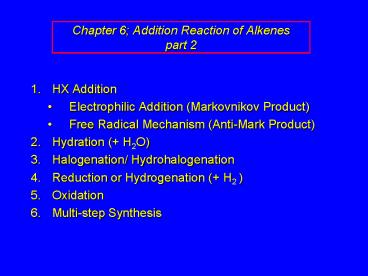Chapter 6; Addition Reaction of Alkenes part 2 - PowerPoint PPT Presentation
1 / 35
Title:
Chapter 6; Addition Reaction of Alkenes part 2
Description:
... Lone Pair on Bromine Stabalizes Carbocation and Forms Cyclic Bromonium Ion Step 2; Bromide Ion Must Attack from Oppositte Side of Cyclic Bromonium Ion ... – PowerPoint PPT presentation
Number of Views:390
Avg rating:3.0/5.0
Title: Chapter 6; Addition Reaction of Alkenes part 2
1
Chapter 6 Addition Reaction of Alkenespart 2
- HX Addition
- Electrophilic Addition (Markovnikov Product)
- Free Radical Mechanism (Anti-Mark Product)
- Hydration ( H2O)
- Halogenation/ Hydrohalogenation
- Reduction or Hydrogenation ( H2 )
- Oxidation
- Multi-step Synthesis
2
Addition of Halogens to Alkenes
- electrophilic addition to double bond
- forms a vicinal dihalide
X2 Cl2 or Br2
F2 explosive I2 endothermic
3
Example
Br2
CH3CHCHCH(CH3)2
CH3CH
CHCH(CH3)2
Br
Br
(100)
4
Stereochemistry of Halogen Addition
- anti addition
Anti Addition Two Bromines add to opposite
sides of the ring
5
Example
H
Cl2
H
trans-1,2-Dichlorocyclooctane73 yield only
product
6
Mechanism is electrophilic addition
- Br2 is not polar, but it is polarizable
- two steps (1) formation of bromonium ion
- electrophilic attack
- (2) nucleophilic attack on bromonium ion by
bromide
NET REACTION
CH2CH2 Br2 -gt Br-CH2-CH2-Br
7
Step 1a Formation of Bromonium Ion
Mutual polarizationof electron distributionsof
Br2 and alkene
Electrons flow from alkenetoward Br2
8
Step 1b Electrophilic Addition to form Bromonium
Ion
Part i
Br-
9
Step 1b Lone Pair on Bromine Stabalizes
Carbocation and Forms Cyclic Bromonium Ion
Part ii
Br-
10
Step 2 Bromide Ion Must Attack from Oppositte
Side of Cyclic Bromonium Ion (anti addition)
11
Example
Br2
trans-1,2-Dibromocyclopentane80 yield only
product
12
X2
X
X
alkenes react with X2 to form vicinal dihalides
alkenes react with X2 in water to give vicinal
halohydrins
H2O
X2
X
OH
HX
13
Examples
H2O
H2C
BrCH2CH2OH
Br2
CH2
(70)
Cl2
H2O
anti addition only product
14
Mechanism 1) Cl2 is polarized and adds across
double bond. 2) Ion formed is stabalized by lone
pair of Cl.
15
3) Water attacks chloronium ion from side
opposite (anti addition) carbon-chlorine bond.
This gives trans isomer
16
Regioselectivity
(77)
- Markovnikov's rule applied to halohydrin
formation the halogen adds to the carbon having
the greater number of hydrogens.
17
Hydrogenation (Reduction, H2) of Ethylene
Metal Catalyst
?
?
?
?
HH
- exothermic ?H 136 kJ/mol
- catalyzed by finely divided Pt, Pd, Rh, Ni
18
Two spatial (stereochemical) aspects ofalkene
hydrogenation
- (1) syn addition of both H atoms to double bond
- (2) hydrogenation is stereoselective,
corresponding to addition to less crowded face of
double bond
19
syn-Additon versus anti-Addition
syn addition
anti addition
20
syn-Addition Metal catalyst breaks H-H bonds.
B
Y
C
C
A
X
21
syn-Addition Addition of H2 across double bonds
takes place in two steps.
22
Example of Stereoselective Reaction
H2, cat
Both productscorrespond tosyn additionof H2.
23
Example of Stereoselective Reaction
H2, cat
Top face of doublebond blocked bythis methyl
group
But only thisone is formed.
H2 adds to bottom face of double bond.
24
Oxidation of Alkenes
- Oxidation without bond cleavage (epoxidation)
- Oxidation with bond cleavage
25
Epoxides three-membered rings that contain oxygen
Epoxidation of AlkenesNo C-C Sigma Bond Breaking
26
Example
27
Mechanism of Epoxidation
28
Ozonolysis Strong Oxidizing Agent Breaks CC Bond
1. O3
2. H2O, Zn
29
Multi-step Synthesis
- Making Alkenes
- Reactions of Alkenes
- Alkenes are intermediates in multi-step synthesis
30
?-Elimination Reactions to Make Alkenes
dehydration of alcohols X H Y OH
H
H2O
OH
H
?
?
dehydrohalogenation of alkyl halides X H Y
Cl, Br, I
Base
HBr
Br
H
?
?
31
Specific Addition Reactions
R
R
R
H
HO
HOH
H
C
R
R
1) BH3
2) H2O2/OH-
32
Specific Addition Reactions
anti addition
syn addition
H
H
C
HH
33
Oxidation of Alkenes
- Oxidation without bond cleavage
- Oxidation with bond cleavage
34
Prepare cyclohexane from cyclohexanol
?
Multi-step synthesis uses alkenes as intermediate
35
Prepare 1-bromo-2-methyl-2-propanol from
tert-butyl alcohol
?
(CH3)3COH
1) H2SO4 heat
2) Br2
H2O































